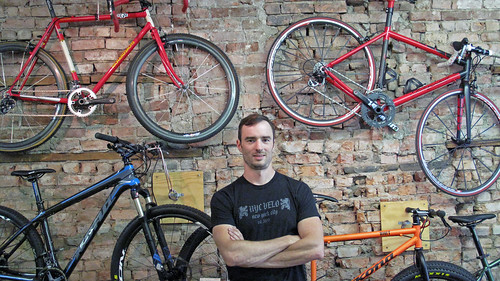For every East Village business that’s opening or closing, dozens are quietly making it. Here’s one of them: NYC Velo.
Andrew Crooks raced bikes in college and then graduated to become an engineering consultant in Houston, Tex. He was coming to New York City a few times a month when he decided it was time to shift gears, career-wise. “When I made that list of what I’d like to do for 70 to 80 hours a week, cycling was at the top of the list,” he said. When he opened NYC Velo seven years ago on Second Avenue (a popular commuter route even before it got a bike lane) the East Village’s other bike shops specialized in used rides. On the other hand, NYC Velo’s brand new bikes are priced from $400 to $4,000: hence clientele like Robin Williams and Leo DiCaprio. We asked the bicycling enthusiast turned entrepreneur how he’s managed to make it.
Have the bike lanes brought you more business?
It’s hard to pin it on the bike lanes. We chose the location long before there was a lane. We do tailor our schedule around the commuting culture so we’re open later for people riding home from work and who might stop by because they need something. We open later in the morning because not a lot of things happen in the East Village before 11 a.m.
Is there a business you look to in the East Village as an example?
I really like what Abraço Espresso is doing. They are a good example of an East Village business. They are tiny and started on a shoestring budget by a couple that works really hard and is focused on quality but keeps loyal to their own character and personality which they allow to shine through. I like how the East Village is made up of all these small parts that have resisted being dominated by the larger retailers and restaurants that typically take over.
Do you feel the East Village is still that way?
To an extent, yes. It’s moving from that direction like most places, but if you look at other neighbors we still feel like the East Village and still have a lot of small, creative businesses. But with the rents rising, at a certain point it comes to be where it’s not financially viable to have a business here. That means people aren’t able to take risks on an idea that is hard proven. The sense of experimentation disappears. People become afraid not to cater to the mainstream.
Why don’t you sell used bikes?
With a used bicycle we can never be certain of the product. You never know if there are hidden gremlins in there and for us to go through a bike for five hours to know if there is nothing funky under the paint or if it’s stolen is just something we can never guarantee. Also, there wasn’t a shortage of that kind of bike business in the East Village.
When you sell pricey bikes, what advice do you give your customers about preventing theft?
The key is to store your bike indoors and never lock it outside. We sell what we believe are the best locks, but you have to be responsible with them. You have to lock it to something that isn’t removable like a tree or scaffolding.
You’ve seen a tree removed for a bike?
We’ve seen the aftermath of people removing a tree for a bike. If you have to keep your bike locked outside lock it in a well lit area and make sure the lock is installed properly and used properly.
How has your rent changed over the last seven years and what is your square footage?
It was $7,500 when we started and now it’s around $10,000. The real estate agent will tell you this space is 2,000 square feet, but it’s really more like 1,700.
That seems like reasonable rent these days for the amount of space you have.
We rent directly from the owner who used to live above with his family. They didn’t want a bar or restaurant below them so that really limited a lot of businesses coming in. He was interested in keeping the space occupied for a long time and not vacant from tenants not able to afford a higher rent. Also, when we moved into the space we did a lot of renovations to it ourselves.
How much did you invest in renovation?
I did them myself for about $40,000. We put in floors and took out walls. We took out all the moldy dry wall plaster on the walls. We put in windows that had been filled and we removed the material put in there. We did a lot of painting. We improved the profile of the building about tenfold.
You have three more years left on your 10-year lease. Will you renew?
There are a lot of variables that go into it. It depends on what the next 10 years are going to cost. It depends on what else is available in the neighborhood. We outgrew this space probably about four years ago so there are other storefronts that would be better suited. Something on a corner and with a higher ceiling, or something wider but maybe shorter. But it’s about what is available when you need it and what will that cost. Then it’s what are the transfer costs? How much will it cost to renovate a new space? Will we be out of business while we’re doing that? What is the cost for communicating our move to people? A lot of factors to consider. Either way we plan on staying in the East Village. It would be nice to be near Central Park but unfortunately we can’t move the East Village up there.




